Most potential entrepreneurs getting into the Food Truck business have a set goal and idea, start to finish, about what food they want to serve. It’s usually the first step that gets the wheels turning towards their new dream career and lifestyle. But there are still some owners who, even when mostly done, have almost no idea concerning the final menu. Whether this is based out of a base drive focusing on the business aspects and potential of the food truck idea itself or their original plans had to be completely wiped free due to unforeseen circumstances or a harsh reality, the fact remains that some owners can be left heavily debating between different menu styles and food ideas that have yet to grab a hold of them.
But no worries! There are plenty of clear factors in popular trends, local habits and physical restrictions that can help YOU narrow down these foggy thoughts and find the food that’s right for your business. We have some of our own ideas on thoughts and foods to consider, which should all be run through one step at a time.
 What Works?
What Works?
In my opinion, when you have no real clue or drive towards one food or another, the best place to start is simply asking this: What’s going to be the most successful?
And for Food Trucks, that’s food that carries Portability. If you can get something a person can eat with one hand and go on their way, you have hit the jackpot to success. This often means Pressed Sandwiches (Grilled Cheese especially), Burritos/Wraps, Pastries (sweet or savory, the British Pastie is a classic street food), Ice Cream Cones/Sandwiches, or something on a Stick. Start with those, or something along those lines, for grabbing an idea and go from there. Other items, like Tacos, Burgers, Waffles, and Gyros, just to name a few, also offer popular street food options with a little less portable statures, but should start considering only IF you’ve had to eliminate all the previous categories.
Besides Portability, another strong aspect to get food to stand out is the use of Fusion Faire. The Korean Taco Trucks were one of the first to bloom and reach mass attention, and it’s safe to say that some of the more exciting vendors are those that stuff one cuisine style into the package of another. Whether it’s putting Indian Curries in a Burrito, Korean BBQ on a Waffle, or Southern BBQ in a Vietnamese Bahn Mi, offering something different than the usual can gain much attention. Simply look at what package you’re looking to serve things in and what different cuisines you can possible work into it, then continue exploiting the idea throughout the menu.

At the end, you want to make something that is unique to YOU, a menu that will draw people to the truck out of curiosity. We’ll discuss the idea of making something completely new or twisted later, after all the other considerations have been put into place.
WHO are you Serving?
What’s the food culture in your area? Are you in the South where BBQ rules the street, on the Coast where one has amazing access to seafood, or the Midwest where people love digging into hot comfort food meat-and-potatoes kinds of things? First look at that to see what does well, or even better to introduce something that DOESN’T normally come into that area; bring Tacos to South Dakota, Indian and Asian-style BBQ to Texas, perhaps some French or Cajun fair in San Francisco. Choosing either of these poles, customer favorites or rare treasures, can easily form the basis behind a solid idea.
What times are the streets active? Is it just lunch time, or is there an active nightlife that can be taken advantage of? There are plenty of cities that have trucks parked out after 10pm, in which case exploring deep-fried, cheese-covered, and other snacky ‘craving’ foods can definitely benefit. Or perhaps there are breakfast/brunch hours with people headed to work that intersect on the streets, where sandwich or burrito-wrapped egg and meat things, donuts, or waffles-on-a-stick can find success. The main thing to ask is WHICH hours work best and do you just want/need to focus on one period most of the time or try different service spots/hours. If business success only finds lunch or late-night hours, that makes it easier, since you’ll want to focus on a single kind of cuisine to fit that crowd. However, if there’s the ability to park throughout the day; a breakfast spot, lunch spot, and dinner/late night, then you’ll want food that can change styles easily and comfortably, probably focusing a LOT on portability. Sandwiches/Wraps work well here, making sure to load with cheese and bad things late at night; Grilled Cheeses are again popular, and can even be made into dessert using marscarpone with jellies/chocolates/other sweet sauces. Then again, pastry and sweet trucks are popular all day long, and can include donuts, croissants, and danishes for the morning crowd.
But at the end of the day, if all else fails and NONE of these steps listed here help out, the masses provide a great resource for the indecisive owner. Because sometimes the simplest and most straight-forward way to figure things out is to go out on the street and ASK what people like. Have a sign and clipboard, get on social media, poll family members, and ask what sort of food people WANT to see on the street, or what they normally go for. You’ll want some sort of incentive to have them stop when on the street, say free water/snacks or something, considering we all try to avoid those people on the corner with clipboards. Give it a try at some point; could even have a multi-choice between the ideas you’re debating and see what usually rings with people the most, or present a single style idea and ask what sort of toppings/fillings/flavors others would be interested in trying with it (and don’t just narrow down, keep them all listed in the back for Seasonal Specials). These are the people you’ll be serving, why not listen to what they have to say?
 Looking at Competition
Looking at Competition
Basically the biggest reason not to go for the cuisines that ARE the most commonly loved in your area, for I’m sure by now there are already quite a few trucks already doing it. But if not then go ahead. The main thing is to see how many other trucks are in your city, and what kinds of menus are often served; if there’s 5 or more BBQ Trucks out there, maybe you shouldn’t go that route unless you’re already head-over-heals a BBQ fanatic who wants to open their own place. But if that was the case, you wouldn’t need help figuring out menu now would you?
Though it’s not just what’s frequent, but what’s popular. When one of the most popular trucks on the street serves Lobster Rolls or Arepa Sandwiches, do you want to take the risk of trying to compete with their already-established customer base with a similar item they may not like as much? If you’re really confident and believe in your product, go for it! But taking this train of thought into consideration can help narrow down what foods to NOT consider when on the road to finding your own perfectly unique food truck menu.
Looking at Cooperation
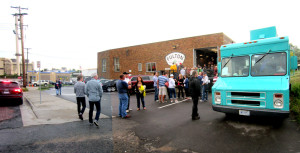
One of the BEST avenues to find regular parking spots and customers is local Breweries, working together to provide food for their taproom while they bring in people that can buy from your truck (we’ve written an article about doing that successfully Here). If that’s a strong possibility that you can tap into, then one will want food that can fit the atmosphere; sandwiches, burgers, salty deep fried foods, bowls of things covered in cheese (nachos, tator tots, or just a sandwich), etc.
It doesn’t always stop at breweries though. Plenty of cities and trucks try looking in other avenues for working food trucks into other things; besides just events, some stop outside certain bars and restaurants at night, offering foods that place doesn’t have, not for competition but to give the customers an extra thing to go with or after their night. That in turn can bring more people to that spot. But as you’re looking into events and successful parking locales, do take a look into OTHER specific businesses/buildings that would welcome a truck outside(I know a truck that regularly visits an air force base), and then ask the question: What would THOSE people want for lunch? This strategy is what started the highest success in the original catering trucks that would find themselves next to construction sites and other work buildings around lunch. Often some sort of sandwich/sub, burrito, or taco has proved popular.
Budget Budget Budget
If you’re still struggling, chances are by now you’ve at least worked out a food budget, which can be used to figure out a few key details. How much money one can allocate can easily determine how much one can spend on special and fun ingredients/items (bacon isn’t so cheap anymore you know?). Menu size is also quite tied to this; the more one has, the wider selection and variety one can allocate, perhaps allowing a BBQ Truck venture or collection of Gastro-pub sammies, sliders, and tacos; smaller budgets, however, will likely mean that it’ll have to be kept simpler. Either by only a few menu items or ones that are all based around the same base (everything wrapped in Pita/Tortilla, served on Tator Tot Beds, etc) with slightly different fillings/toppings.
If you have to lower the budget from your initial idea, it doesn’t mean one has to lower the quality of main ingredients. There are plenty of menu styles that focus and excel off of purely cost-effective ingredients. For instance Mac and Cheese (or other pasta-based) trucks, which is mainly just super-cheap dried pasta, milk, flour, and some kind of cheese. The latter is probably the biggest cost (that or milk), but bought in bulk like it is then that shoots down ever further. Final items can be customized with vegetables, herbs, and an addition of meat like bacon or sausage for an extra charge. It’s versatile too; can be squished into a ball with breadcrumbs and deep-fried, stuffed into a tortilla, between bread, etc.
That last one reminds me of Grilled Cheese Trucks, another easily cost-effective option; bread and cheese focused, YOU can choose from an infinite listing of unique fillings for flavor, whether it’s different cheese combos or simple cooked vegetables. Soup-based menus are not only cost-effective, but can even last and be re-heated on future days. The best part is, not only are cost-effective menus surprisingly easy to figure out, but with a SLIGHTLY lowered menu price (there’s no use in lowering the budget if you’re losing the exact same amount in profit) they’re highly appealing to customers.
Equipment
You can only put up a certain menu if you actually have the ingredients, provided by budget, and the equipment to cook them that way. If a decision is made before outfitting the truck, this issue is null, just need to get the right e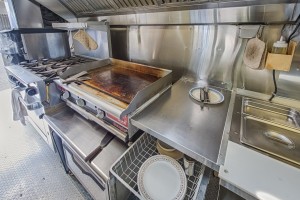 quipment to serve it up. On the other hand, if one has already been stuck with a fully outfitted truck, and/or perhaps had to buy it used and working with what that already has, one may run into issues.
quipment to serve it up. On the other hand, if one has already been stuck with a fully outfitted truck, and/or perhaps had to buy it used and working with what that already has, one may run into issues.
There are plenty of cooking equipment that can be used in quite flexible methods, we go in length about their common and collective purposes in an article Here, but the fact remains they all have restrictions. One can’t safely deep fry in a truck without a Friar, eliminating any possibilities for regular Fries or guilty fried Snacks; PROPER BBQ cannot be made easily or en masse without a Smoker (there are ways to smoke on a stovetop or grill, but that’s smaller batch); and you’ll need a stovetop and oven if you want any chance to have anything that needs hours of stewing/roasting during prep periods. But that said, flat-top griddles can be used for all kinds of sandwiches, pressing items (from paninis to quesadillas), even quick steaming with a lid and some water. A Broiler can substitute grilled flavors and effects. And a Pizza Oven can cook more than just pizza.
Going Unique
S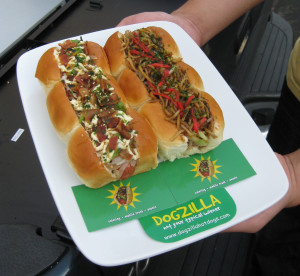 ometimes, the best way to build a successful truck is not to look at PAST popular concepts, but to start something completely different on your own. Take every key note and restriction that you’ve explored so far and twist that into something a regular business wouldn’t think to offer. THAT’S where your truck’s identity and personality will come from and shine.
ometimes, the best way to build a successful truck is not to look at PAST popular concepts, but to start something completely different on your own. Take every key note and restriction that you’ve explored so far and twist that into something a regular business wouldn’t think to offer. THAT’S where your truck’s identity and personality will come from and shine.
The first key to taking this approach (vs offering a classic kind of food/cuisine, or simple fusion, usually with a few different kinds of food/packaging offered) is keeping it simple. You’re offering the ONE KIND of food and changing up the main flavor, whether it’s a stuffing or topping or whatever. For instance, say one does a truck focused on Deep Fried Mac n Cheese Balls; instead of complicating it with bowls of straight mac n cheese, grilled cheese sandwiches, and all that, just have different balls on the menu. One Plain, Bacon-Herb Flavored, stuffed with BBQ Pork in the middle, a creamy Ricotta ‘Dessert’ one, or even some cheesy Arancini options(deep fried Risotto Balls). A Waffle-on-a-Stick truck should always have some sort of ‘waffled’ on a stick, Empanada places shouldn’t try getting Hot Dogs in, and you see where this is going. The reason to do this is to create Focus; not just for customers, but for yourself; all your attention is spent making this one kind of thing extremely well, instead of having to consider all the other factors and prep/service methods for other kinds of food on top of it. Service becomes smoother since it’s all the same process and takes the same time, and equipment needs scale down.
But one STILL needs to figure out their final item. By now you should have hopefully researched the other local trucks and people’s interests enough to narrow down certain realms of food/cuisine to reach for. The next step to making it unique is looking at that food and figuring out different ways one can ‘form’ it; like the Fusion cuisine with flavors, sometimes offering different shapes or ways that make holding easier can amount to fun and success. There’s a Pretzel truck that shapes them all to look like curly mustaches, and another truck that takes Empanada dough and fries it in a Cone shape before stuffing with their meat. That’s not to mention the bevy of things that can forced on or around a skewer.
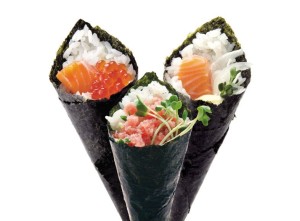 OR, one can go unique in another way. Instead of looking into new ways to present something, research your food and the countries/regions it’s from… and use something that’s not being utilized yet. I’ve found that sometimes there are certain foods, perfect for serving on the street and/or out of a truck (often how they started in the street markets), that no one has capitalized on yet. Japan alone has dozens. Just imagine, a truck that served only Dango (sweet dumplings on skewers), or Yakitori (small kabobs of specific meats, grilled over intense charcoal with special glazes), or those Eggy Sprout/Veggie Pancakes of theirs. In my hometown, there’s a Sushi Food Truck that does all the main styles… but not Temaki. Let me premise by saying that Temaki is where the rice and seaweed is rolled into a cone, the seafood/filling stuffed down the middle. An actual item that is PERFECT for the street; it’s easy to hold, delicious, fresh made, usually item
OR, one can go unique in another way. Instead of looking into new ways to present something, research your food and the countries/regions it’s from… and use something that’s not being utilized yet. I’ve found that sometimes there are certain foods, perfect for serving on the street and/or out of a truck (often how they started in the street markets), that no one has capitalized on yet. Japan alone has dozens. Just imagine, a truck that served only Dango (sweet dumplings on skewers), or Yakitori (small kabobs of specific meats, grilled over intense charcoal with special glazes), or those Eggy Sprout/Veggie Pancakes of theirs. In my hometown, there’s a Sushi Food Truck that does all the main styles… but not Temaki. Let me premise by saying that Temaki is where the rice and seaweed is rolled into a cone, the seafood/filling stuffed down the middle. An actual item that is PERFECT for the street; it’s easy to hold, delicious, fresh made, usually item
on the cheaper end of sushi (not adding all these other fancy things to it, and mostly rice), and absolutely unique in character. But they completely avoid the obvious benefits of it. If I could, I’d open up my own just to prove a point, and because it’s awesome.
Well, that rant aside, one can sort of see and imagine the hidden gems in multiple cuisines. Heck, how many people are aware of the wonders of those Ethiopian Pancake platters topped with different ‘stews’ that are eaten using the pancake itself? That could be made into a wrap or unique savory-crepe-like thing. The world is full of possibilities that have yet to be explored by Food Trucks, there’s certainly something that will not only fit your requirements but let your truck stand out at the same time. And with a decision made, the fog lifted, you can sit back down at the desk and bang out all those details and paperwork for the truck which is sorely needed.
Other Helpful Links and Reading Material
Hints for Building Your Food Truck Menu – a For-Dummies chapter considering the OTHER things to keep in mind when developing that food.
How to Start a Food Truck: Decide What You’ll Sell – FoodTruckr’s in-depth paper breakdown for initially going through this thought process

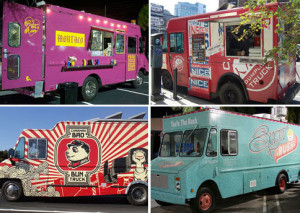
Leave A Comment